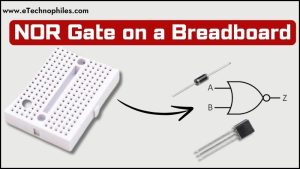Last updated on March 23rd, 2024 at 12:10 pm
I am sure you must be familiar with a NOR Gate, its Truth Table, Logic symbol, and its working. But do you know, you can build your own NOR Gate on Breadboard? So in this post, you will learn how to make a NOR Gate using Diodes and a Transistor on a Breadboard.
**Read Similar Article: And Gate using Diodes
What is a NOR Gate?


NOR Gate is a universal Logic gate. It is simply a NOT Gate connected ahead of an OR Gate. That means we get an inverted output of the OR gate out of a Nor gate. So the output is 1 only when both the inputs are zero i.e. just the opposite of what happens in the case of an OR gate.
We are going to make this NOR gate by combining the OR gate and the NOT gate. Click to See How to build an OR gate and How to build a NOT gate.
You can also watch the video below for quick reference:
Truth Table
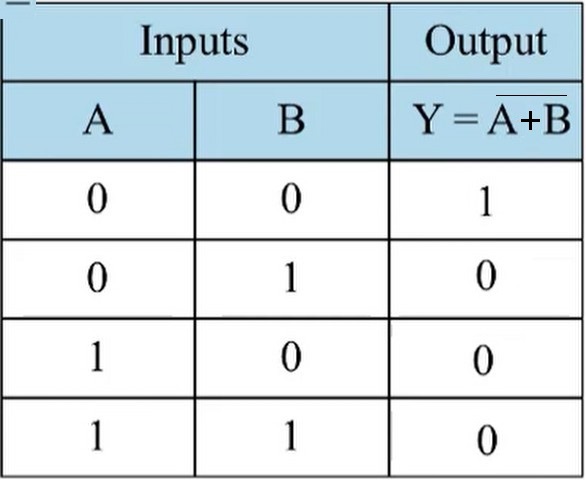
Components required
- 1N4007 Diode X 2
- BC547 Transistor
- 1k Resistor
- 100-ohm Resistor X 2
- LED
- 9 Volt Battery
- Connecting Wires
If you are a beginner and want to know about breadboards in detail, read: How to Use a Breadboard in 5 Easy Steps
Circuit diagram of NOR gate
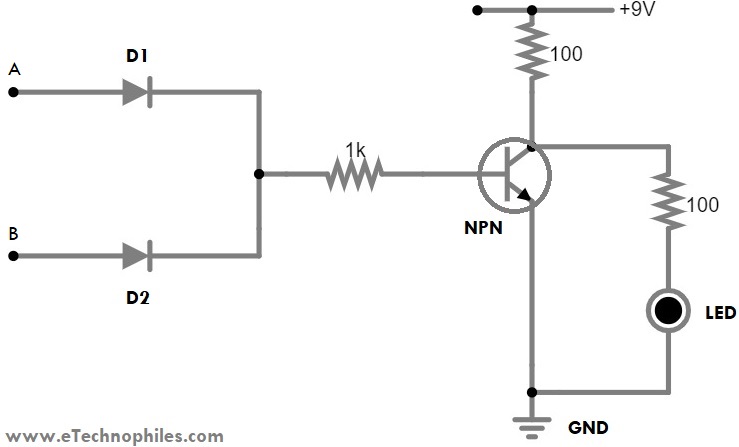
This is the circuit we are going to build on Breadboard.
- N terminal of diodes is connected together.
- Logic inputs are given to the P terminal of diodes.
- End terminals of the Resistance are connected to N- N-terminals of the diode and base of the transistor respectively.
- One 100-ohm resistor is connected from the +VE terminal of the battery to the collector terminal of the transistor.
- Output indicator i.e LED is connected from collector terminal to 100-ohm Resistor to Ground.
- The Emitter terminal of the transistor is connected to the Ground.
- Ground- Negative terminal of the battery.
Steps to make NOR gate on Breadboard
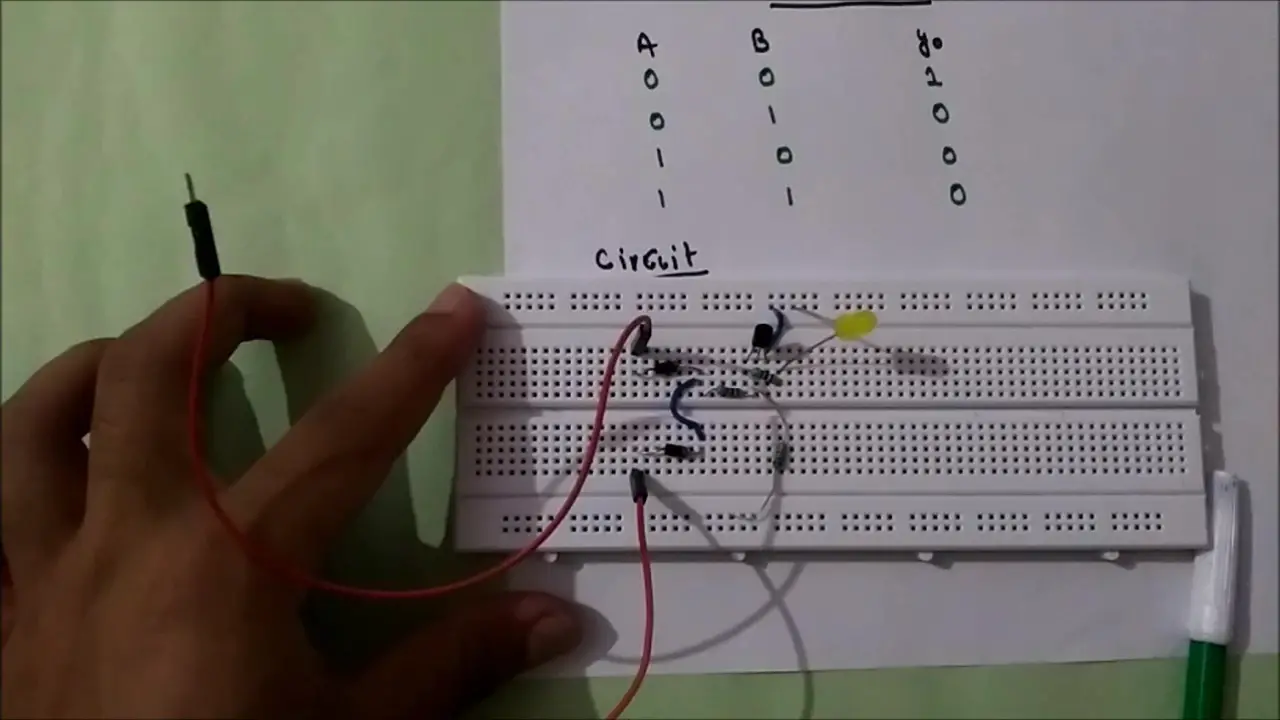
- Place the two diodes, the N-terminal is the silver portion, and the P-terminal is the Black portion.
- Connect two jumper wires, each at the respective p-terminal of the diodes indicating input Logic:
- Connect the N terminal of the Diodes together using wire.
- Place Transistor on a breadboard.
- Connect a 1k ohm resistor from the n terminal of the Diodes to the base terminal of the transistor.
- Now connect the Emitter terminal of the transistor to the ground(battery’s -ve terminal).
- Now connect a 100-ohm resistor from the collector terminal of the transistor to the +ve terminal of the battery.
- Now connect a 100-ohm resistor in series with the LED to the Ground.
WORKING
NOTE: When the P-terminal of a Diode is at a higher potential (>.7v) than its n-terminal, it acts like a short circuit. When the n terminal is at a higher potential, the Diode acts as an open circuit.
NOTE: BC547 Transistor acts as a switch in this circuit. Whenever there is some threshold voltage at the base, the transistor acts like a closed switch from collector to emitter. Whenever there is no or less voltage the threshold voltage at the base, acts like an open circuit from collector to emitter.
CASE 1: Input A=0, Input B= 0 , Output=1 (LED is ON)
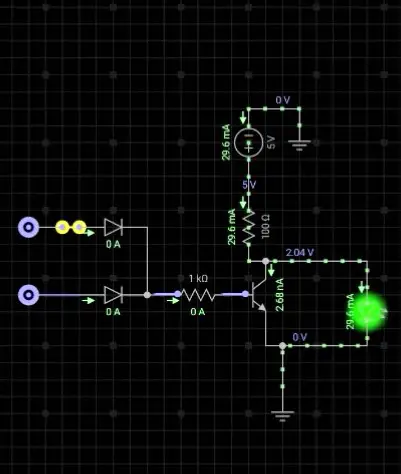
In this case, the p-terminal of both diodes is at 0 volts w.r.t n-terminal which is <.7v and acts like an open circuit. Thus no current flows from the 1k resistor to the base terminal of the transistor.
In this case, there is no voltage at the base of the transistor. So it acts like an open switch from collector to emitter i.e. infinite resistance between collector and emitter.
Due to this, no current flows from the collector to the Ground. All current flows from the 100-ohm resistors to LED and then to ground i.e. through the path of minimum resistance. Hence LED turns on i.e. 1 at the output.
CASE 2: Input A=0, Input B= 1, Output=0 (LED is OFF)

In this case, the p-terminal of diode B is at 0 volts w.r.t n-terminal which is <.7v and hence acts like an open circuit. But the p-terminal of diode A is at a higher potential than its n-terminal which is >.7v. Thus some current flows from 1k resistor to the base of the transistor.
In this case, there is some threshold voltage at the base of the transistor. So it acts like a closed switch from collector to emitter i.e., almost zero resistance between collector and emitter due to this no current flow from 100-ohm resistors to LED and then to ground.
All current flows from the collector to the Ground i.e., through the path of minimum resistance. Hence LED turns off i.e., 0 at the output.
CASE 3: Input A=1, Input B= 0, Output=0 (LED is OFF)

In this case, the p-terminal of diode B is at 0 volts w.r.t n-terminal which is <.7v and hence acts like an open circuit. But the p-terminal of diode A is at a higher potential than its n-terminal which is >.7v. Thus some current flows from the 1k resistor to the base of a transistor.
In this case, there is some threshold voltage at the base of the transistor. So it acts like a closed switch from collector to emitter i.e., almost zero resistance between collector and emitter.
Due to this no current flow from 100-ohm resistors to LED and then to ground. All current flows from collector to Ground i.e. through the path of minimum resistance. Hence LED turns off i.e., 0 at the output.
CASE 4: Input A=1, Input B= 1, Output=0 (LED is OFF)

In this case, the p-terminal of both diodes is at a higher potential w.r.t n-terminal which is >.7v and acts like short circuits. Thus some current flows from 1k resistor to the base of a transistor.
In this case, there is some threshold voltage at the base of the transistor. So it acts like a closed switch from collector to emitter i.e. almost zero resistance between collector and emitter.
And due to this no current flow from 100-ohm resistors to LED and then to ground. All current flows from collector to Ground i.e. through the path of minimum resistance. Hence LED turns off i.e., 0 at the output.
** Hence we get 1(LED is ON) at the output only when both the inputs are 0 as given in the Truth Table.
